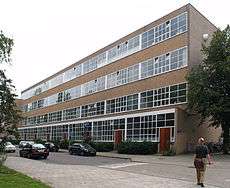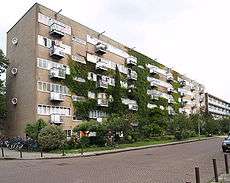Piet Zanstra

Piet Zanstra (1905-2003[1]) was a Dutch architect who designed a number of important buildings in Amsterdam in the post-World War II period. He is best known, perhaps, for his Maupoleum,[2] which was demolished in 1994, and for the Caransa Hotel, which still stands on the Rembrandtplein.
Biography
Zanstra was born in Leeuwarden, on 7 August 1905. He studied hydraulics there and became apprenticed to an architect. Soon he worked with notable architects such as W. M. Dudok and J. P. Kloos, and in 1932 started a design studio with Jan Giesen and Karel Sijmons. With them he built a combined studio/apartment building on the Zomerdijkstraat in Amsterdam, now hailed as an early example of what in Dutch architecture is called Nieuwe Bouwen. With his two colleagues Zanstra belonged to an architects' society called Group '32, a gathering of functionalist architects who were inspired by Le Corbusier in particular.[3]
He founded ZZDP in 1954, which became one of the largest architectural firms in the country in the 1960s and 1970s[4] and built such notable buildings as the Rembrandt Tower.
Notable buildings
- Artists' studios and apartments on the Zomerdijkstraat, in the Amsterdam neighborhood Rivierenbuurt (1934, with Jan Giessen and Karel Sijmons).[5]
- Europarking, parking garage on the Marnixstraat, Amsterdam (1971, with Ab Gmelig Meyling and Peter de Clercq Zubli)[6]
Gallery
-

Zomerdijkstraat, north face
-

Zomerdijkstraat, south face
-
.jpg)
Church
-
Ramps, Europarking
-
Hervormde Kerk De Ark, Slotervaart, Amsterdam Nieuw-West
References
- ↑ Heuvel, D. van den; Mesman, M.; Quist, W. (2008). The Challenge of Change: Dealing with the Legacy of the Modern Movement: Proceedings of the 10th International DOCOMOMO Conference. IOS Press. p. 540. ISBN 9781607503712.
- ↑ Buurman, Marlies (28 May 2003). "Piet Zanstra 1905 - 2003". ArchiNed (in Dutch). Retrieved 8 September 2014.
- ↑ "Piet Zanstra, 07-08-1905 - 23-05-2003". Treasures of the NAI (in Dutch). Nederlands Architectuurinstituut. Retrieved 8 September 2014.
- ↑ Mens, Noor. "ZZDP Architects-Entrepreneurs". Retrieved 8 September 2014.
- ↑ "Atelierwoningen Zomerdijkstraat, Piet Zanstra, Jan Giesen, Karel Sijmons Dzn., Amsterdam". architectuurgids.nl (in Dutch). Retrieved 8 September 2014.
- ↑ "Parkeergarage Europarking, Piet Zanstra, Ab Gmelig Meyling, Peter de Clercq Zubli, Amsterdam". architectuurgids.nl (in Dutch). Retrieved 8 September 2014.